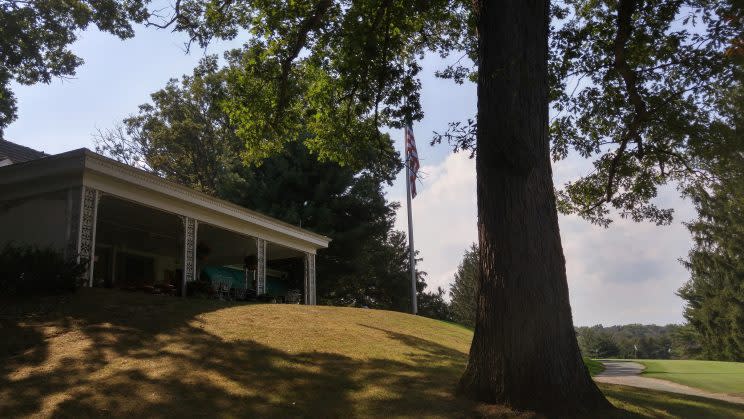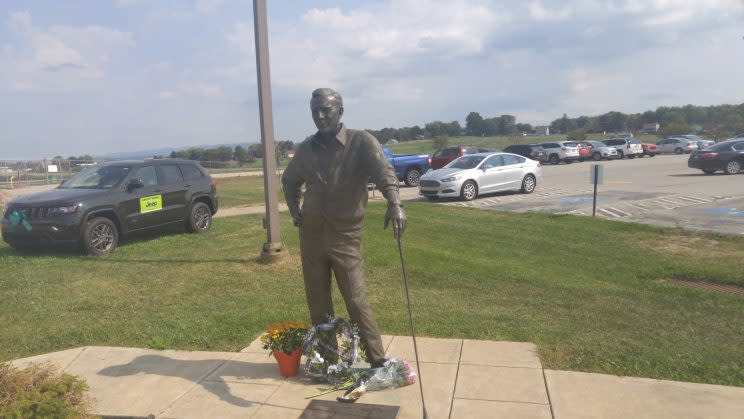Arnold Palmer's hometown of Latrobe mourns his death, ponders its future
LATROBE, Pa. — Driving west on U.S. Route 30, you’ll go under an overpass welcoming you to Latrobe.
On the side of the overpass, it reads: “Welcome to Latrobe – It’s A Beautiful Day in the Neighborhood.”

It’s a tip of the cap to Fred Rogers, who was born in the town on March 20, 1928. Just about 18 months later, Arnold Palmer entered this world here, too.
Make no mistake: Latrobe might be Mr. Rogers’ neighborhood, but it’s Arnold Palmer’s town.
Palmer died on Sunday at a Pittsburgh hospital from heart complications. The seven-time major winner was in the city, another 40 minutes west down Route 30, for a scheduled Monday procedure.
The outpouring from the golf world was immediate and immense. Most everyone here has an Arnold Palmer story, and most everyone has been quick to tell theirs in wake of the news. Palmer’s health had been on a somewhat steady decline in recent years, with various ailments and maladies piling up – the nature of aging.
Palmer had a pacemaker inserted in August 2014. Five months later, he tripped over his dog in his Orlando condo, dislocating his shoulder. Digestive issues plagued him. Despite it all, Palmer tried to keep some semblance of a regular life, spending the summer in his Latrobe home and welcoming people from all walks to his home and office. Golfers would visit to say hello and pay homage. Pittsburgh Steelers players, in town for training camp at nearby St. Vincent College, drove down Arnold Palmer Drive and up the driveway to spend time with the King.
Latrobe is a town of less than 8,500, but for decades, it has centered on one part-time resident.
For his part, Palmer’s life centered on a two-square-mile radius of western Pennsylvania hills which sit in the shadow of the Laurel Hill peak. His name is all over the place, in part a town-sized homage to his life and career and partly a result of his reinvestment in the place he called home.
Of course, there’s Arnold Palmer’s Latrobe Country Club, the club his father Deacon helped build and where he was the greenskeeper, then head pro. Arnold Palmer bought the club in 1971, and his Latrobe home sits on top of a hill overlooking the front nine of the course.
A police car sits guard at the bottom of the hill, next to a pillar on which a sign reads “Private Drive.” However, for Palmer, seclusion ran counter to his essence. Until near the end of his life, Palmer could often be found somewhere on club property, amid his Army. He could be found in the club’s grill room, where you could order his signature half-iced tea, half-lemonade drink. High school golfers might have seen him cruising around the course on a cart during one of their matches, taking the time to applaud them for a remarkable shot. Palmer hit balls on a near daily basis. Latrobe Country Club’s driving range resembles a more fertile version of where Roy McAvoy practiced in “Tin Cup,” with hand-cut yardage markers sitting up every 50 yards.

There’s nothing pretentious about Latrobe Country Club, a reflection of Palmer himself. From the outside, the clubhouse looks like a bigger version of your grandma’s house – unassuming, secluded in the trees and largely unchanged by time. Inside, however, is a monument to Palmer’s adventures. Eye-distracting pictures of Palmer, his first wife Winnie and second wife Kit, as well his family, friends and rivals adorn the walls, hallways and stairwells. Trophies abound.

And yet, Latrobe Country Club has simultaneously been a sprawling mausoleum to Palmer’s father. Deacon Palmer still has a locker in the locker room resembling an upscale high school gymnasium. There’s a statue, carved from a tree, of Deacon to the left of the 18th fairway. Palmer’s father had his ashes spread near the club’s 18th green, and, per his will, the King’s remains will be released in the same spot.

Less than two miles from the club and his home is Arnold Palmer Regional Airport, renamed for the golf legend in 1999. The small airport – the trek from check-in to terminal is maybe 100 feet – served for decades as Palmer’s personal runway, the place where the King took off and landed when he was engaged in his other greatest passion: aviation. In recent years, the airport has become increasingly popular for commercial airliners. Spirit Airlines uses the airport as a small hub with flights up and down the East Coast, as well seasonal routes to other destinations.

Just outside the one way in and out for passengers, a life-sized statue of Palmer stands. A handful of comers and goers left flowers at the feet of the statue, while the American flag at half-staff blew in the seasonably warm breeze.
Less than a half-mile from the airport, you can buy a car with Arnold Palmer’s signature on it from his Cadillac-Buick dealership. Arnold Palmer Motors has been in business since 1981, with the front plate space pre-loaded with a piece of metal bearing Palmer’s signature.
Palmer quotes and tributes lined Route 30 on Monday, on sign after sign at businesses grateful for the 62-time PGA Tour winner’s life, influence and occasional patronage.
They begin before entering town.
“Thank You Mr. Palmer”
“A True Legend Never Dies RIP Arnie”
“God Bless You Arnold Palmer”
“Arnold Palmer You Will Be Sorely Missed”
The Walgreens staff shared their favorite Palmer quote: “The most rewarding things you do in life are often the ones that look like they cannot be done.”
Arnold Palmer’s life story is one of transforming doubt into success, time and again. Now, as Latrobe mourns Palmer’s passing, there’s also a sudden unease about the town’s touchpoints with the golf legend’s surviving family – ranging from the petty to the foundational.
The rumor in town goes that Palmer specifically demanded the Westmoreland County Airport Authority keep parking free at the airport, a condition of using the legend’s name to drive some foot and air traffic. With the airport continually growing, that Palmer perk may go away.
It’s unclear if Arnold Palmer Motors will continue on in the wake of his passing.
Most importantly, the future of Latrobe Country Club is in doubt. Membership has declined in recent years, and Palmer personally financed club losses so it would break even. In an effort to stem running as deep into the red, Latrobe Country Club has offered tee-sheet access to guests of a Springhill Suites across the street from the regional airport. The hotel is a mini Palmer museum, adorned with memorabilia and pictures – a public extension of the Latrobe clubhouse.
On club property, too, there are a few cottages that can put up Palmer admirers just steps away from hallowed ground in golf. Without the direct connection to Palmer, it’s unclear how the club will continue. A whispered suggestion emerged that the club could open further to the public, an interactive park of sorts honoring Palmer.
All things cars, planes and carts aside, Palmer’s philanthropy will be missed. He quietly supported countless charities, with donations of memorabilia, signed merchandise, tee times and personal appearances. He helped support pediatric care, libraries, public gardens and more – many without so much as a mention of his generosity. It’s unclear how much the Palmer estate might still shape Latrobe and broader western Pennsylvania.
The future of Arnold Palmer’s substantial piece of Latrobe has already been somewhat set into motion, per his final instructions and preparation. For as much as Palmer may have looked at times like he was winging it on the golf course, he was a shrewd and prepared businessman. And there will be time to sort out the details after a private funeral late this week and a public remembrance next Tuesday at St. Vincent College. Right now is a time to stop and say thanks.
Latrobe, though, hasn’t come to a screeching halt. Arnold Palmer may have put the town on the map, but it moves on as it weeps for his loss. On Monday at Latrobe Country Club, a scheduled Monday tournament took over his course. It was for St. Vincent’s athletic programs, an example of how Palmer will posthumously continue to help the area.
As thousands flood here to pay their respects, many will head back home from Latrobe eastward on Route 30. As they leave, they’ll go under that overpass again – the one welcoming everyone to the neighborhood. However, as the sun sets behind them going the other way, they’ll see the other side of the bridge.
It says, “Greater Latrobe Area Legend Arnold Palmer,” with his emblematic umbrella an exclamation point.
The sign is a reminder that, in life, and now in death, Latrobe is Arnold Palmer’s town.
Ryan Ballengee is a Yahoo Sports contributor. Find him on Facebook and Twitter.
LISTEN TO OUR WEEKLY GOLF PODCAST! This week: Assessing the 2016 Ryder Cup teams

 Yahoo Sports
Yahoo Sports 

